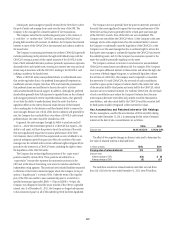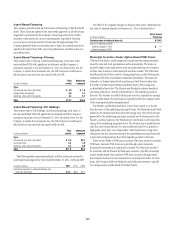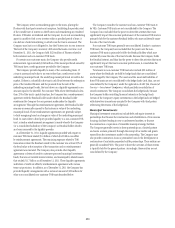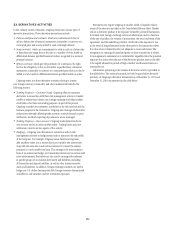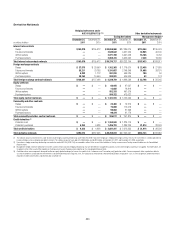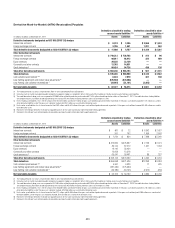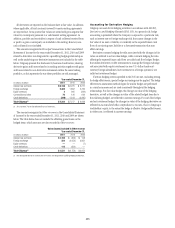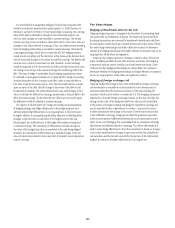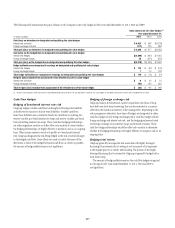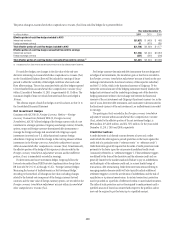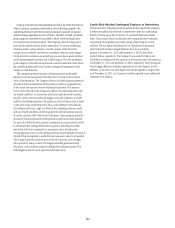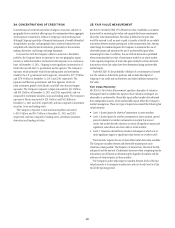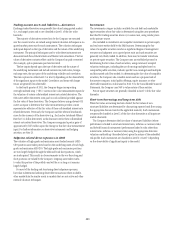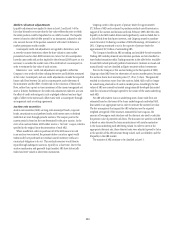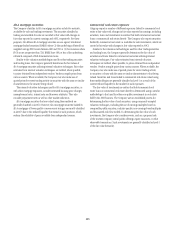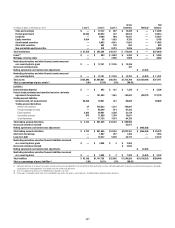Citibank 2011 Annual Report Download - page 260
Download and view the complete annual report
Please find page 260 of the 2011 Citibank annual report below. You can navigate through the pages in the report by either clicking on the pages listed below, or by using the keyword search tool below to find specific information within the annual report.
238
The pretax change in Accumulated other comprehensive income (loss) from cash flow hedges for is presented below:
Year ended December 31,
In millions of dollars 2011
Effective portion of cash flow hedges included in AOCI
)NTERESTæRATEæCONTRACTS $(1,827)
&OREIGNæEXCHANGEæCONTRACTS 81
Total effective portion of cash flow hedges included in AOCI $(1,746)
Effective portion of cash flow hedges reclassified from AOCI to earnings
)NTERESTæRATEæCONTRACTS $(1,224)
&OREIGNæEXCHANGEæCONTRACTS (257)
Total effective portion of cash flow hedges reclassified from AOCI to earnings (1) $(1,481)
æ )NCLUDEDæPRIMARILYæINæOther revenueæANDæNet interest revenue ONæTHEæ#ONSOLIDATEDæ)NCOMEæ3TATEMENT
For cash flow hedges, any changes in the fair value of the end-user
derivative remaining in Accumulated other comprehensive income (loss)
on the Consolidated Balance Sheet will be included in earnings of future
periods to offset the variability of the hedged cash flows when such cash
flows affect earnings. The net loss associated with cash flow hedges expected
to be reclassified from Accumulated other comprehensive income (loss)
within 12 months of December 31, 2011 is approximately $1.1 billion. The
maximum length of time over which forecasted cash flows are hedged is
10 years.
The after-tax impact of cash flow hedges on AOCI is shown in Note 21 to
the Consolidated Financial Statement
Net Investment Hedges
Consistent with ASC 830-20, Foreign Currency Matters—Foreign
Currency Transactions (formerly SFAS 52, Foreign Currency
Translation), ASC 815 allows hedging of the foreign currency risk of a net
investment in a foreign operation. Citigroup uses foreign currency forwards,
options, swaps and foreign-currency-denominated debt instruments to
manage the foreign exchange risk associated with Citigroup’s equity
investments in several non-U.S. dollar functional currency foreign
subsidiaries. Citigroup records the change in the carrying amount of these
investments in the Foreign currency translation adjustment account
within Accumulated other comprehensive income (loss). Simultaneously,
the effective portion of the hedge of this exposure is also recorded in the
Foreign currency translation adjustment account and the ineffective
portion, if any, is immediately recorded in earnings.
For derivatives used in net investment hedges, Citigroup follows the
forward-rate method from FASB Derivative Implementation Group Issue
H8 (now ASC 815-35-35-16 through 35-26), “Foreign Currency Hedges:
Measuring the Amount of Ineffectiveness in a Net Investment Hedge.”
According to that method, all changes in fair value, including changes
related to the forward-rate component of the foreign currency forward
contracts and the time value of foreign currency options, are recorded in the
Foreign currency translation adjustment account within Accumulated
other comprehensive income (loss).
For foreign-currency-denominated debt instruments that are designated
as hedges of net investments, the translation gain or loss that is recorded in
the Foreign currency translation adjustment account is based on the spot
exchange rate between the functional currency of the respective subsidiary
and the U.S. dollar, which is the functional currency of Citigroup. To the
extent the notional amount of the hedging instrument exactly matches the
hedged net investment and the underlying exchange rate of the derivative
hedging instrument relates to the exchange rate between the functional
currency of the net investment and Citigroup’s functional currency (or, in the
case of a non-derivative debt instrument, such instrument is denominated in
the functional currency of the net investment), no ineffectiveness is recorded
in earnings.
The pretax gain (loss) recorded in the Foreign currency translation
adjustment account within Accumulated other comprehensive income
(loss), related to the effective portion of the net investment hedges, is
$904 million, $(3,620) million, and $(4,727) million, for the years ended
December 31, 2011, 2010 and 2009, respectively.
Credit Derivatives
A credit derivative is a bilateral contract between a buyer and a seller
under which the seller agrees to provide protection to the buyer against the
credit risk of a particular entity (“reference entity” or “reference credit”).
Credit derivatives generally require that the seller of credit protection make
payments to the buyer upon the occurrence of predefined credit events
(commonly referred to as “settlement triggers”). These settlement triggers
are defined by the form of the derivative and the reference credit and are
generally limited to the market standard of failure to pay on indebtedness
and bankruptcy of the reference credit and, in a more limited range of
transactions, debt restructuring. Credit derivative transactions referring to
emerging market reference credits will also typically include additional
settlement triggers to cover the acceleration of indebtedness and the risk of
repudiation or a payment moratorium. In certain transactions, protection
may be provided on a portfolio of referenced credits or asset-backed securities.
The seller of such protection may not be required to make payment until a
specified amount of losses has occurred with respect to the portfolio and/or
may only be required to pay for losses up to a specified amount.


